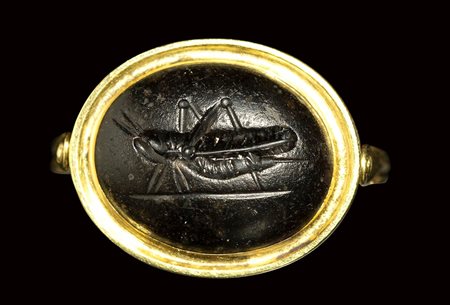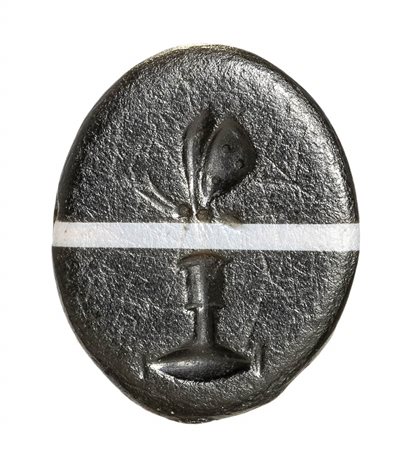ASTA 107 - Glittica
-

Lotto 73 A roman dark agate intaglio set in a gold swivel ring. Grasshopper.
1st century B.C. - 1st century A.D.
Fine depiction of the insect, facing left. Use of globular elements. Groundline. Slight wear marks. 18th - 19th century swivel mounting.
Stone 11 x 14 mm; ring size 16,5 x 18 mm; 2,93 gr
Provenance: UK private collection D.C.
-

Lotto 74 A roman banded agate intaglio. Allegorical emblema with a butterfly.
1st century A.D. - 1st century B.C.
Very fine and elegant allegorical emblem with a butterfly resting on an object to be identified (ampoule?). Slight wear marks.
8 x 10 x 2 mm. -

Lotto 75 A roman nicolo intaglio. Turtle.
1st - 2nd century A.D.
The animal is facing left, and is characterized by a rounded head that comes out of the shell, and two small visible legs. Missing on the edge and wear marks. Rare.
7 x 9 x 2 mm. -

Lotto 76 A roman red jasper intaglio mounted on a silver ring. Ibis on a turtle with a snake.
2nd century A.D.
The oval stone is depicting an ibis standing and turned left catching/eating a snake with its beak. He is standing on top of a turtle. Groundline. The references to the god Mercury are various in this scene— the ibis bird, also known as the animal representation of the god Thot, egyptian pendant of Hermes; the turtle closely linked to Hermes and seen as his animal-attribute (Hermes made the first lyre with a turtle’s shell, see Homeric Hymn to Hermes, 24-61).
Early 20th century silver mounting, the shoulders decorated with engraved leaves. Published in: Theodora Hadzisteliou Price, "An Ionian Silver Ring with Sard" in Antike Kunst, 15, 1972, pp. 60-63.
Stone 10 x 12 mm; ring size 17 x 18 mm; 3,50 gr.
From the old collection of Prof. Constantine Athanasius Trypanis (1909-1993), found on the lands of his father Athanasius G. Trypanus in 1905. -

Lotto 77 A roman agate intaglio. Seagoat with astrological attributes.
1st century A.D.
The sea creature to the left, holding the globe in its paws. Above, a crescent moon; below, a star. Astrological intaglio engraved on a layered agate. Traces of the ancient iron mounting. Wear marks.
10 x 12 x 4 mm. -

Lotto 78 A roman nicolo intaglio. Hunting scene.
2nd - 3rd century A.D.
A lion attacks a bull, biting him on the shoulder and assaulting him from behind. The mighty quadruped folds his legs to the ground as a sign of defeat. Scene inspired by greek models.
10 x 12 x 2 mm.
Provenance: UK private collection. -

Lotto 79 A rare nicolo agate intaglio set in a gold ring. Allegorical scene with animals.
1st - 2nd century A.D.
A snake emerges from a snail shell (or sea shell) and opens its mouth wide against a parrot. The bird is there in front of the shell. Behind, a branch of a tree. Rare scene. The gem is mounted in an elegant chiseled gold ring with floral and plant motifs, dating to the 19th century.
Stone 11 x 13 mm; ring size 15 x 18 mm; 3,07 gr.
Provenance: UK private collection. -

Lotto 80 A roman dark glass paste intaglio set in a gold swivel ring. Eagle.
1st - 3rd century A.D.
The animal is depicted frontally, with its wings open and the head turned in profile. With his claws he grabs a boar's head. Emblem of imperial military power. Wear marks. Little missing on the mounting. Parallel: For a same glass paste intaglio see Metropolitan Museum of Art database, inv. n. 17.194.56.
Glass 10 x 11 mm; ring size 17 x 18 mm; 2,53 gr.
Provenance: UK private collection. -

Lotto 81 A roman obsidian intaglio mounted on a modern gold ring. Eagle on altar.
2nd century A.D.
The scene depicts an eagle standing on an altar. His head turned left. Chips on the edge of the stone.
The mounting made in 18k gold, with rounded hoop extending in broader shoulders with an oval box-setting.
Stone 10 x 12 mm; ring size 18 x 19 mm; 7,26 gr.
-

Lotto 82 A roman carnelian intaglio set in a gold ring. Eagle.
2nd - 3rd century A.D.
The intaglio shows an eagle in front, his head turned left with widespread wings. The gold mounting is with rounded hoop extending on the shoulders with terminal tubular endings and rounded box-setting. Presence of a hallmark on the hoop.
int diam 19 mm; intaglio diam 10 mm; 6,03 gr. -

Lotto 83 A roman carnelian intaglio mounted on a modern gold ring. Eagle on a stand.
2nd century A.D.
The intaglio shows an eagle with the head turned right holding a laurel branch in its beak. He is standing on a crossed-legs stand. Allegory of military power of the roman Empire. Slight wear marks on the surface of the stone. The gold mounting is with rounded hoop, within two spherical beads on each side. The shoulders with engraved lines are ending in foliage. The rounded box-setting with engraved leaves motifs. Hallmark on the hoop.
int diam 19 mm; intaglio 10x11 mm; 2,56 gr.
-

Lotto 84 A roman carnelian intaglio. Emblema of victory with eagle and latin letters.
2nd century A.D.
The stone shows an eagle, his body turned right meanwhile his head is turned left. Framed by two military standards. Groundline. Beneath, two rows of latin inscription « LXICL » « PF ». Military victory emblema.
12x16x3 mm -

Lotto 85 A roman carnelian intaglio. Bird on a scale.
2nd - 3rd century A.D.
A bird stands on a scale, symbol of the Harmony and of the Justice, allegory of Balance. Rare iconography.
9,5 x 12 x 2 mm.
Provenance: UK private collection.
-

Lotto 86 A rare agate cameo set in a modern gold ring. Partridge.
2nd - 3rd century A.D.
The bird is facing right, with its head slightly lowered forward. The engraver masterfully used the polychrome clear layer over a dark background with naturalistic purpose. The colors of the stone imitate the plumage and cartilages of the bird. Little missing on the edge, as the stone was pierced as a bead. Parallel: for the same subject, on the same stone with the same style see U. Pannuti, Catalogo della collezione glittica vol II, Napoli, Museo Nazionale, pp. 281-283 (Farnese Collection).
Stone 13 x 16 mm; ring size diam. 18 mm; 11,83 gr. -

Lotto 87 A roman carnelian intaglio. Griffin with deer.
2nd - 3rd century A.D.
The hunting scene consists of a winged griffin attacking a deer that has fallen to the ground. The composition is inspired by classical Greek models. Groundline. Slight wear marks.
13 x 18 x 6 mm. -

Lotto 88 A roman yellow jasper magical intaglio. Lion with moon and stars.
2nd - 3rd century A.D.
The mighty feline walks to the left, surrounded by three stars and a crescent moon. The astrological attributes denote the magical character of the gem. The presence of the breasts reveal that she is a lioness. Groundline. Slight wear marks.
11 x 15 x 3 mm. -

Lotto 89 A roman carnelian intaglio. Dog with prey.
1st - 2nd century A.D.
Hunting scene composed of a dog biting a hare. Groundline. Attractive color of the stone. Slight wear marks.
9,5 x 12 x 3 mm. -

Lotto 90 A rare burnt chalcedony intaglio. Ritual procession with Apis.
1st - 2nd century A.D.
The bull characterized by a crescent moon on its head can be identified as Apis, the Egyptian deity, the sacred bull son of Hathor. Behind him there are three characters as in a sacral procession. A figure points up towards an inscription (to be identified). The stone is burnt and has a lack on the edge. Rare iconography referable to the Isiac cults in Rome.
8 x 12 x 3 mm. -

Lotto 91 A roman carnelian intaglio. Eros on a lion.
1st - 2nd century A.D.
The mighty feline walks to the right, carrying a winged erote on its back. The erote grabs the lion's mane to hold on. Groundline. Allegory of love that subdues the strenght. Slight wear marks.
12 x 15 x 3 mm. -

Lotto 92 A roman rock crystal intaglio. A mouse riding a chariot with swans.
2nd century A.D.
The scene depicted shows a mouse riding a chariot toward right, with two swans. The movement is rendered by the widespread wings and the raised heads of the swans. Groundline. AGDS Munchen, vol. 2 n. 918-919.
12x14x5 mm -

Lotto 93 A roman red jasper intaglio. Shrimp.
1st century A.D.
Shown in profile to the left, the crustacean with its inwardly curved tail is engraved in great detail and naturalism. Slight wear marks.
Provenance: English art market.
12x15x3 mm
-

Lotto 94 A roman green chalcedony intaglio set in a gold ring. Heafer under a tree.
2nd century A.D.
The animal is facing left. Beautiful color of the stone, set in a close collet with ropetwist details, openwork, love knot shoulders and double wire shank. Published: Diana Scarisbrick for S.J. Phillips Ltd, The Wellington Gems. (Catalogue) published on the occasion of the exhibition June 8-10, 13-17, London 1977, cat n. 14: "Gold ring with bloodstone (sic) intaglio. A cow. Roman".
Stone 7 x 9 mm; ring size 17 x 18 mm; 4,90 gr. -

Lotto 95 A roman carnelian intaglio set in an ancient gold ring. Rabbit.
2nd - 3rd century A.D.
The animal is facing left. Groundline. Wear marks. D section hoop with flared shoulders.
Stone 8 x 11 mm; ring size 15 x 19 mm; 5,65 gr. -

Lotto 96 A roman gold ring set with a three-layered agate intaglio. bucrane.
1st - 2nd century A.D.
Rounded hoop with broader shoulders and rounded box-setting containing a three-layered agate intaglio. Bucrane seen in front with garlands. The mounting presents some shocks and the box-setting seems to be wider than the intaglio. Although both elements are genuine and ancient, the mounting does not seem belonging to the intaglio.
Stone diam. 8 mm; ring size diam. 18 mm; 3,71 gr.
